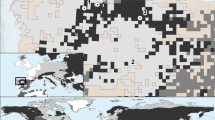Abstract
Maternal attendance behaviour was studied in Antarctic (Arctocephalus gazella) and subantarctic fur seals (Arctocephalus tropicalis) which breed sympatrically at subantarctic Macquarie Island. Data on attendance were obtained using telemetric methods. Both species undertook two types of foraging trips: overnight foraging trips which were of less than 1 day duration and occurred exclusively overnight, and extended foraging trips which lasted longer than 1 day. The mean duration of overnight foraging trips was 0.43 and 0.39 days, while the duration of extended foraging trips was 3.6 and 3.8 days in A. gazella and A. tropicalis, respectively. The duration of overnight and extended foraging trips did not differ significantly between species. Two types of shore attendance bouts that differed in duration were also observed in these species. Short attendance bouts lasted less than 0.9 days, while long attendance bouts lasted longer than 0.9 days. Short attendance bouts lasted 0.4 and 0.5 days, while long attendance bouts lasted 1.6 and 1.7 days in A. gazella and A. tropicalis, respectively, and did not differ significantly between species. The most significant differences between the attendance behaviour of both species was in the percentage of foraging time allocated to overnight foraging trips (15% and 25% in A. gazella and A. tropicalis, respectively), and the percentage of time spent ashore (30% and 38% in A. gazella and A. tropicalis, respectively). The nearness of pelagic waters to Macquarie Island is considered to be the main reason that lactating females are able to undertake overnight foraging trips. These trips may be used by females as a means of optimising the costs of fasting and nursing ashore. Females may be able to save energy by only nursing pups when milk transfer efficiencies are high, and reduce the time and energy costs of fasting ashore when milk transfer efficiency is low. Of the female A. gazella that still carried transmitters at the end of lactation, 83% continued regular attendance for between 21 and 150 days post-lactation (when data collection ceased). Overwintering of A. gazella females at breeding sites has not been previously reported in other populations.
Similar content being viewed by others
Author information
Authors and Affiliations
Additional information
Accepted: 10 November 1998
Rights and permissions
About this article
Cite this article
Goldsworthy, S. Maternal attendance behaviour of sympatrically breeding Antarctic and subantarctic fur seals, Arctocephalus spp., at Macquarie Island. Polar Biol 21, 316–325 (1999). https://doi.org/10.1007/s003000050368
Issue Date:
DOI: https://doi.org/10.1007/s003000050368




